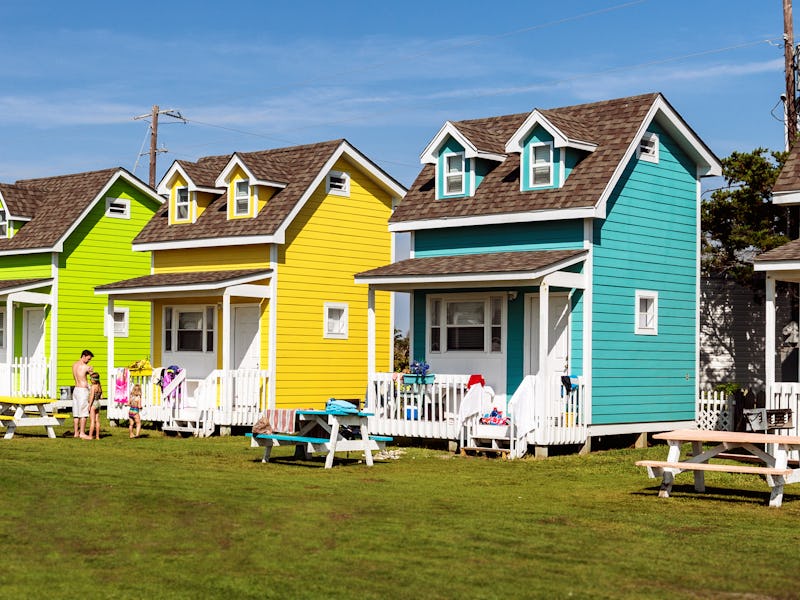The Big Psychological Issues at Stake With Tiny Homes
A tiny home does not necessarily translate to a tiny personality -- and that can be a problem.

Move over, McMansions of the nineties and aughts: Tiny homes are here to take over.
Generally between 100 and 400 square feet, the tiny homes that are trendy these days come in a variety of forms: small portable cabins or a trailer rigged to look like a Pinterest fantasy. Then there are the urbanite cousins of the tiny house — micro-apartments — first established in Japan in the 1970s and now a new addition to the Manhattan real estate market.
“I think tiny homes are really interesting because one of the things we’ve seen, as people design and personalize them, is that their values are reflected in their home space,” Lindsay Graham, a researcher specialist at the Center for the Built Environment within the University of California, Berkeley, says. “What’s cool about tiny homes is that the entire space is sort of a broadcast of some sort of value that you hold in relation to homes, sustainability, and how you’re living your life.”
Graham ventures that the motivations behind living in a tiny home likely revolve around a desire to live more modestly while conserving resources, which according to the resource site The Tiny Life is exactly in line with the tenets of the “tiny house movement.” Environmental consciousness, self-sufficiency, and the desire for a life adventure are all listed as inspirations for going small — and the tiny house itself becomes a banner flag for the values its occupant feels defines them as a person.
The typical tiny house is between 100 and 400 square feet.
Environmental psychologists reason that homes are influential on the emotional state of people because they “facilitate the social interactions and the power dynamics that are played out in a home,” according to a 2015 paper co-written by Graham. Fair, but the problem with tiny houses is that they can be ground zero for the type of conflict unique to tight quarters: They physically demand extremely specific social relationships that not everyone can — or should — maneuver. Dak Kopec of Boston Architectural College told The Atlantic that micro-apartments could “definitely be unhealthy for older people … who face different stress factors that can make tight living conditions a problem.” A family in a tiny house is likely a cramped one — which can create a chain reaction of stressors.
It’s also fair to argue that people with families or who are attached to many possessions would never dream of living in a tiny home. “With choosing tiny homes, I would suspect that it’s a certain type of person who is going to be gravitating towards those spaces and it’s again the people who have values that they feel are being reflected by living that way,” says Graham. “We try to match our spaces to the activities that we need to accomplish.”
Approximately 68 percent of people with tiny houses don't have a mortgage.
Those who do want to live in tiny homes exhibit two psychological mechanisms in particular: clustering and self-verification. Clustering, or self-sorting, is the idea that we tend to hang out with like-minded individuals. Clustering is further enhanced by a process called self-verification — we want to be seen in ways that we are aligned with our identities. It’s what makes Facebook and Instagram more than personal diaries for us; like a home, they’re a reflection of our values and lifestyles and what we want others to imagine us to be.
“I think it is likely that people who are living in tiny homes do have a particular sort of personality,” environmental psychologist Sally Augstin tells Inverse. “If you live in one, you probably have a high need for uniqueness and you enjoy having an intellectual challenge — to find a way to live in a tiny home means you have solved lots of different puzzles. It is the sort of environment that allows you to create a space that sends messages that are important to you and align with your personality.”
Years of environmental psychological research has taught experts like Augustin that things like light control and natural features like wood-grain are inexpensive ways to make a home more comfortable and relaxing. Access to natural light is key, she says, as is making sure that the colors of the walls are lighter which make them seem farther away — less eggplant, more sage green. Augustin also recommends that people have different light bulbs for different activities — more golden for relaxing, more blue for working — and says to keep the place from being visually complex. There’s a reason why The New York Times describes New York’s new nine-story micro-apartment building as “hipster Scandinavian.”
Inside a tiny house.
While the list of characteristics describing the ideal tiny house candidate is distinct — doesn’t have children, wants to live cheaply, doesn’t mind sacrificing space for simplicity — the tiny house movement appeals to a surprisingly broad demographic. Miniature habitats are spreading worldwide, from Madrid to the American Midwest. Graham compares the purposeful design of a tiny home to that of a space ship — just like NASA brings in psychologists to understand how the physical space of a shuttle will affect the mindset of astronauts, so should architects work with psychologists to build tiny homes. However, that doesn’t seem to be the popular choice so far.
“I think that it’s very important for psychologists to be involved [in tiny architecture planning],” says Graham. “One of the shortfalls within architecture and the design industry is that they have concepts of what they want to the user to do, or how they want that space to be used, but often there is a big disconnect between what the actual occupants need and the vision of the design team.”